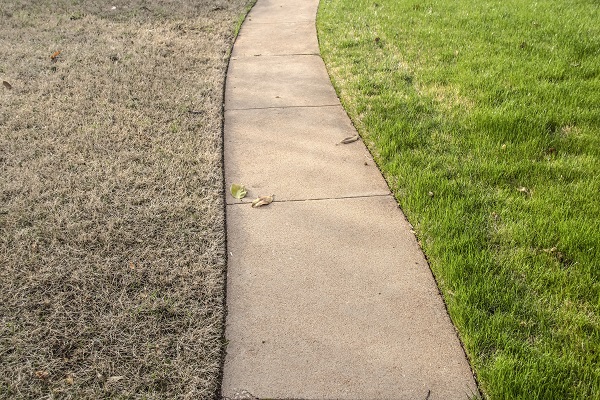How to Bring Your Lawn Back to Life in Spring and Summer
Wednesday, July 22nd, 2020In a perfect world, dead grass would just come back to life and start growing again. However, that is not the way it works. So if you’re looking at your brown lawn and wondering, “Will dead grass grow back?” Here is your answer:
Dead grass will not grow back; you will need to buy fresh sod to make your lawn look good again. That being said – there is a difference between dormant and dead grass. If your grass is dormant it will come back; it’s just not growing during a particular season.

To check if your grass is dormant or dead, it helps to know the type of grass you have. Bermuda grass, like Midiron for example, is a type of grass that goes dormant in the winter. When grass is dormant, you can tell because it will usually pull out easily. It’s also important to check the roots—white roots are good and live, while black roots indicate the grass is dead or dying.
What are the Main Causes of Patchy Grass?
Patchy grass can result from either dead or dormant grass. If your entire lawn is dead, you will need to remove the dead grass, prep the soil, and lay new sod.
When your whole lawn is the same brown color, the grass may be dormant. Cool-season grasses will go dormant in the summer when the sun produces prolonged periods of hot temperatures, while warm-season grasses will go dormant during the winter. In these cases, the grass is still alive and will come back to life and return to a beautiful hue when its intended season returns.
If your lawn is green in some areas and brown in others, you might be dealing with dead patches in the lawn but not an entirely dead lawn. To fix dead patches, rake out the dead area gingerly, fertilize it, and water it; eventually, it should come back.
Should You Sprinkle Seed to Fix Patches of Dead Grass?
This is a common question. The answer is that you do not need to buy seed and sprinkle it on your lawn. If you do decide to seed, you need to know which type of grass you have. Many grasses are hybrid, which means they do not produce seeds. The exception to this rule is winter (cool season) sod; seed sprinkling would work for winter sod because these grasses (fescue, for example) do have seeds.
Instead of seeding, you might consider buying small patches of sod to fix dead patches. If you sprinkle seed on dead patches and you don’t know why type of sod you have, you will end up with a non-uniform lawn texture and appearance.
What Are Some Ways to Grow Grass in Arizona?
If you want your grass to remain green year-round regardless of the temperature, you can plant a mixture of cool- and warm-season grasses. This process is called overseeding. Overseeding enables your lawn to grow thicker, produce a better color, and have greater resistance to pests and the elements because there’s more seed-to-soil contact. Overseeding for a winter lawn should begin around October in Arizona. Conversely, your summer lawn prep should begin in the late spring or early summer.
Scalping for Early Summer Grass
In the late spring or early summer, you should scalp your lawn to get rid of the dead tissue that builds up on the sod over time. In doing so, you will give way for new tissue to come in. Once you have scalped your lawn, give it a little food because that is what it will need to grow. There are wrong and right ways to transition your Arizona sod lawn in the springtime. For example, the type of fertilizer you choose matters, as does the ongoing temperature. Be sure to read up on the type of grass you have and the appropriate steps for transitioning your lawn in the spring or fall before you set to work on your lawncare plan.
So there you have it. We hope this article has helped answer your questions about dead grass growing back.
At Evergreen Turf, we are proud to be Arizona’s lawncare experts. We invite you to stop by our location in Chandler, Arizona if you have questions or need help ensuring your lawn is as beautiful and bountiful as it can possibly be. If you have a dead lawn, we can help you choose the right grass for your unique home or office property.

